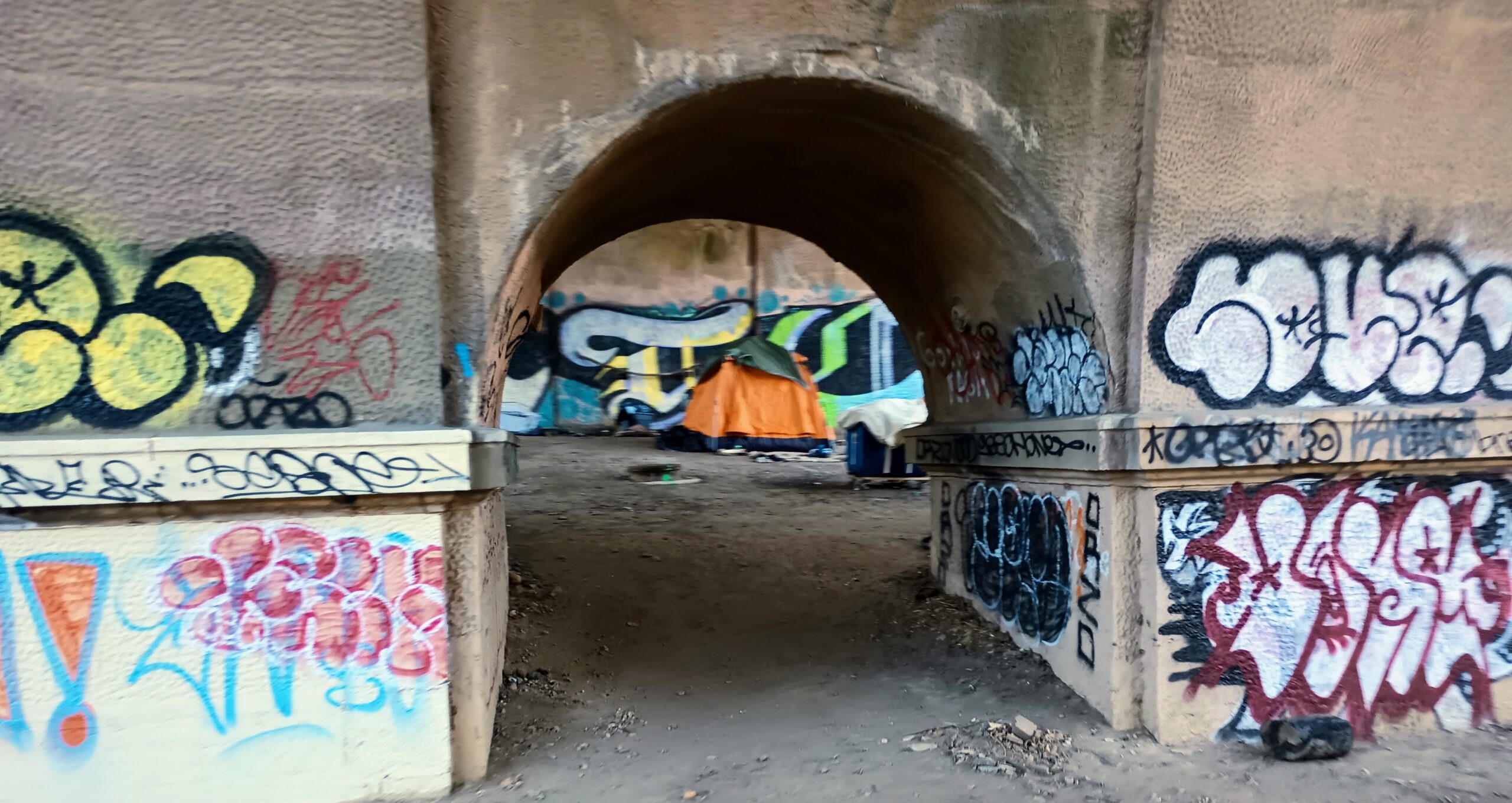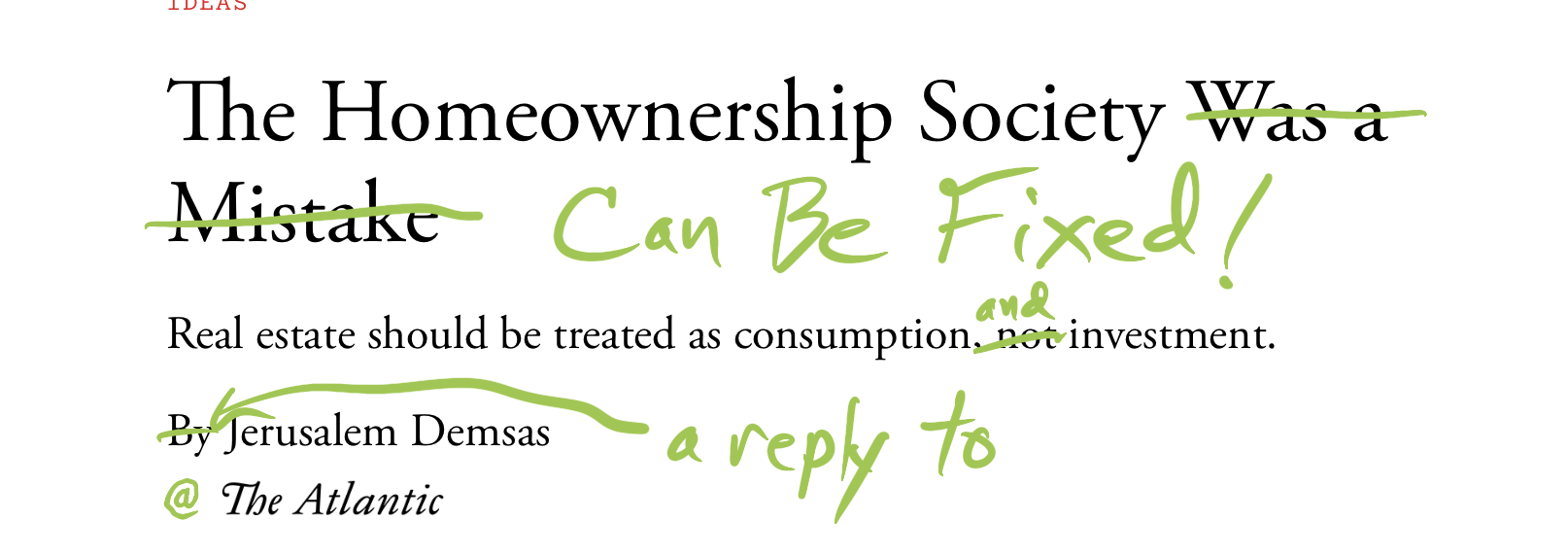Physical Address
304 North Cardinal St.
Dorchester Center, MA 02124
Physical Address
304 North Cardinal St.
Dorchester Center, MA 02124

One common NIMBY* argument is that new housing (or the wrong kind of new housing) will “destroy the neighborhood.” For example, one suburban town’s politicians fought zoning reform in New York by claiming that allowing multifamily housing “is a direct assault on the suburbs.“ Indeed, many people do seem to believe that apartments and houses are somehow incompatible. But I saw an interesting counterexample recently. A couple of weeks ago, I attended the CNU (Congress for the New Urbanism) conference in Charlotte, North Carolina. CNU usually sponsors neighborhood tours, and I toured Myers Park, one of the city’s richest neighborhoods. Myers Park was built in the 1910s; most blocks are dominated by large single-family houses with an enormous tree canopy. Although Myers Park is only a couple of miles from downtown Charlotte, it certainly looks suburban, if by “suburban” you mean low-density and dominated by houses. (According to city-data.com, the neighborhood density is just below 4000 people per square mile, less than that of affluent Long Island suburbs like Great Neck and Cedarhurst). And yet on one of the neighborhood’s major streets (Queens Road) apartments and houses seemed to alternate. This does not seem to have reduced home values; the average value of detached homes there is over $1 million, about four times the statewide average. Moreover, Myers Park apartments are not the sort of “missing middle” housing that is virtually indistinguishable from a house. I saw a five-story building in Myers Park: not a skyscraper but definitely not something that looks like its neighbors. Not far away is a four-story building that looks like it has a few dozen units. In other words, apartments and houses can coexist, even in places that are very suburban in many ways. *As many readers of this blog probably know, NIMBY is an […]

In a recent Mackinac Policy conference, Detroit’s Mayor Mike Dugan proposed *drum roll* a land value tax. Sort of. Mayor Dugan’s proposal would create separate tax rates for land and capital improvements (i.e. the buildings on top). Specifically, he wants to decrease the tax rate on buildings by ~30% and increase rates on land by ~300%. The change would increase revenue for the city and also cause a series of second order effects. Taxing Blight & Rewarding Investment Detroit’s existing tax structure disincentives development. Holding vacant land or land with dilapidated (i.e. assessed as worthless) structures is cheap from a tax perspective. Actually developing land triggers a tax increase because of the brand new structure who’s value gets figured into the tax bill. What’s worse, the existing tax system encourages land hoarding. Land speculators sit on neglected parcels on the off chance that a developer needs it as part of a larger project. To caveat that, though, not all land speculation is bad. Holding some land off market and releasing it later into a development cycle can have positive benefits. In Detroit’s case, however, these are mostly vacant lots and abandoned buildings creating public health hazards the city has to deal with. The Political Economy of Land Value Taxation Unexpectedly – for me as a latte sipping coastal urbanite in California – Dugan’s LVT would also lower tax bills for homeowners. Land values in Detroit are low — in absolute terms and relative to structure values. Making the shift to taxing the less valuable land component of a property nets out positive for most homeowners. And the fact that it’s a win for homeowners makes me think it’s politically viable, both in Detroit and elsewhere. In places struggling to get back on a growth footing — places where land values […]
As various housing reform bills work their way through the lawmaking process in American state legislatures, several new legal challenges to local land use and zoning ordinances are simultaneously underway in state and federal courts. Among these courtroom efforts are challenges to occupancy restrictions, short-term rental bans, inclusionary zoning and single-family zoning itself. On May 9, 2023, the Pacific Legal Foundation filed a complaint on behalf of two plaintiffs in the United States District Court for the District of Kansas challenging a City of Shawnee ordinance (Ordinance No. 3419) which prohibits more than three unrelated adults from living together in a single residence. These limits, often adopted by localities as a means of excluding student renters or other groups of persons who are perceived as subverting the proper purpose of the so-called single-family home, are challenged by the plaintiffs as a violation of the constitutional right of free association and specifically the right to select and establish a household. The lawsuit also alleges that the ordinance violates equal protection and is beyond the scope of Kansas’ zoning enabling act (K.S.A. 12-741 et seq.), which does not authorize cities to regulate persons based upon blood or legal relationship. In Nevada, the Clark County District Court on February 16, 2023 issued a preliminary injunction blocking Clark County from implementing and enforcing certain sections of its short-term rental ban (Clark County Code, Title 7, Chapter 7.100, Sections 7.100.110-.260). The lawsuit, filed by the Greater Las Vegas Short Term Rental Association, alleges among other things that the ordinance is arbitrary and capricious, reads as unconstitutionally vague, infringes on free association and effects a taking of property. That ruling has now been appealed to the Supreme Court of Nevada. On December 15, 2022, the Institute for Justice commenced a lawsuit on behalf of a Seattle […]
In a pair of posts, Scott Alexander goads his mostly-YIMBY readers by claiming to believe that density is likely to increase prices. To quantify his readers’ views, he laid out a thought experiment in a Google poll, the results of which we’ll no doubt see in a few days. You can see the poll – and my answer – below. As a YIMBY scholar, I mood-affiliate with the first answer, but I chose the middle one because there is a fundamental misunderstanding between pro-housing people like me and Scott’s recent posts. Housing growth is not the same as city densification Scott’s experiment isn’t a “housing growth” experiment, it’s a “city densification” experiment. Crucially, he requires “proportional increases in the number of office buildings, schools, etc”. That is, the experiment would increase office space at the same pace as housing even though office vacancy rates (19%) are far higher than housing vacancy rates (~1.7%). Oakland is a pretty balanced city: as best I can tell from simple Census data, it probably has a jobs/residents ratio pretty close to the California average (by contrast, San Francisco has twice the state jobs/resident ratio). If Scott ran his experiment in a bedroom community, or stipulated that office space is left under current regulations, I’d have an easy time coming down on the “less expensive” side of the ledger. The point of the YIMBY movement is that housing faces uniquely strict regulation. California cities (and those in some other states) believe that offices and industrial uses are “taxpayers”, generating more revenue than they use in services. Housing is viewed as a fiscal cost. Regulation (“fiscal zoning“) and discretionary decisions have reflected this bias for decades. The result is headlines like “SF added jobs eight times faster than housing since 2010.” If Oakland upzoned citywide, it […]
The Terner Center for Housing Innovation at the University of California, Berkeley has released a policy brief summarizing the effect on housing production of the bewildering array of new housing laws California has enacted since 2016. A preliminary analysis of market effects of the new laws, accompanied by findings from interviews with California-based planners and land use lawyers, points toward the effectiveness of simple and direct legislation requiring localities to give ministerial approval to small-scale projects. For other laws, including those prescribing more complex formulas regarding affordability criteria for larger developments, it remains too early to gauge how housing production will respond. Of the legislation that has been enacted to date, California’s accessory dwelling unit laws (beginning with SB 1069 in 2016), according to those interviewed by the Terner Center, have been responsible for the astonishing twenty-fold increase in ADU permits documented from 2016 to 2021. Legislation enacted in 2021 requiring ministerial approval for duplexes and lot splits (SB 9), estimated by the Center to allow for up to 700,000 new units, has not yet been widely used, partly due to localities’ use of other restrictive zoning regulations such as mandatory setbacks to impede use of the law. Further strengthening of this law, in the same manner that the ADU law was fortified through 2019 revisions, may be necessary to unlock its full potential for new home construction. Other new laws are in the early stages of demonstrating their effectiveness. The imposition of stricter requirements on localities’ Regional Housing Needs Allocation (RHNA) process through legislation enacted in 2017 and 2018 has resulted in dramatic increases in zoning capacity targets for the next eight-year period set by the Housing Element Law (of which the RHNA is a part). For Southern California and the Bay Area, total housing allocation has increased from […]
A group of researchers at the Urban Institute came out with a new study on zoning and housing affordability. At governing.com, a headline about the study screamed: “Zoning Changes Have Small Impact on Housing Supply.” The Governing writer’s spin was, of course, “there’s no evidence it [upzoning] makes housing cheaper.” Governing has published numerous articles that criticize pro-supply zoning reform (one of which I critiqued on this blog), so this conclusion seems to fit in with its general point of view. The most important conclusion (to me) of the study is that it reinforces the commonsense view that lower housing supply leads to higher costs. In particular, the study concludes: “Reforms tightening regulations are associated with increased rents, potentially worsening conditions for low- and moderate-income renters.” (page 4, emphasis mine). What about upzonings (reforms that allowed more construction)? The study concludes that they “lead to a 0.8 percent increase in housing supply, on average.” (p. 28). How small is 0.8 percent? In fast-growing Harris County, Texas (Houston and its inner ring suburbs), 17 percent of the county’s 1.885 million units have been built since 2010, or about 1.7 percent per year. So 0.8 percent increase would be only five or six months’ worth of new housing in Houston- not a huge amount. Given the miniscule amount of reform the lack of impact on housing prices should hardly be surprising. In other words, if zoning allows six months’ worth of new housing (compared to the pre-reform status quo), things stop getting worse but don’t really get better. If zoning allows less housing, things get worse.

In a Maryland neighborhood. rent control caused condo conversions of 15 percent of multifamily buildings. The county council might inflict the same fate on the entire region.

I'm pre-disposed to find reasons to love Gregg Colburn and Clayton Page Aldern's book *Homelessness is a Housing Problem*. But the book moved my priors in the opposite direction than the authors intended.

Why are Max Holleran's book, Richard Schragger's law review article, and randos on Twitter all misinterpreting one important research article?

In a recent article, Jerusalem Demsas identified a major housing policy problem but gave an unworkable solution. Michael D. Nahas proposes a workable solution: land-value contracts.